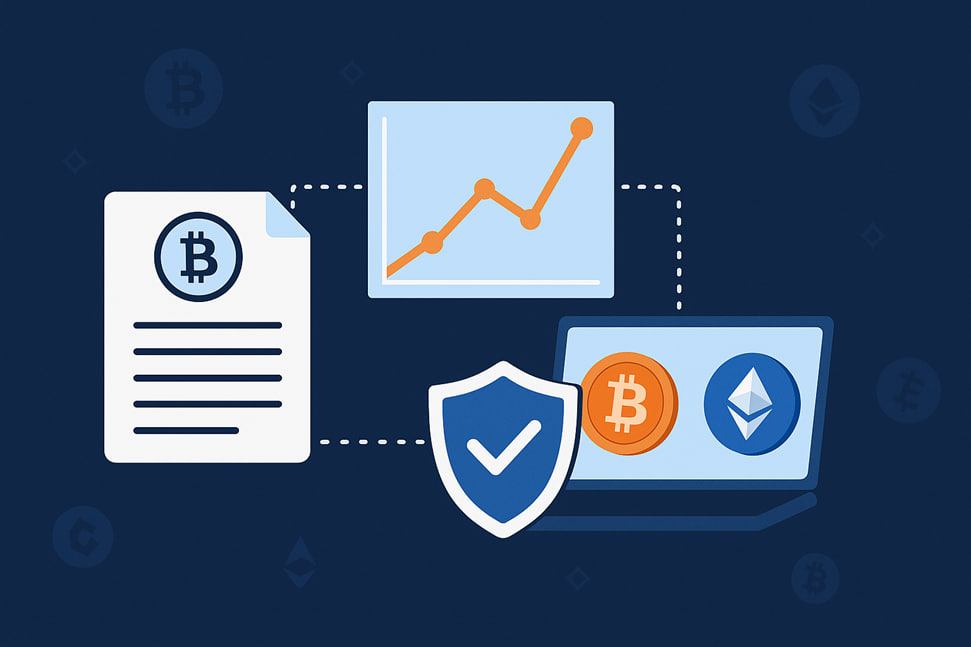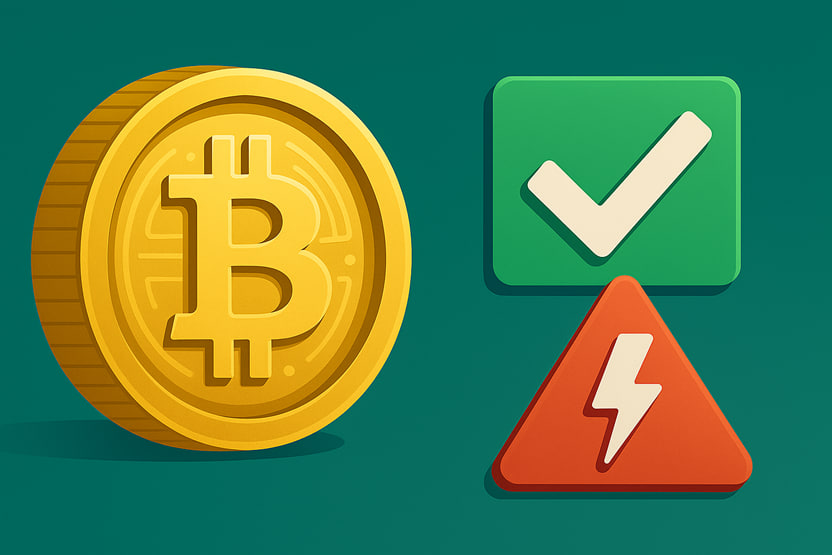What Are Crypto Derivatives? Simple Guide and How They Work

Contents
- Introduction
- What Are Crypto Derivatives
- How Crypto Derivatives Work
- Advantages and Risks of Crypto Derivatives
- How to Start Trading Crypto Derivatives
- Regulation of Crypto Derivatives
- Conclusion
Introduction
Cryptocurrencies have long ceased to be just digital coins. Today, entire financial markets are built on this foundation. One such instrument is crypto derivatives. This isn’t just a complicated word — it’s an essential component of digital asset trading. With their help, traders can profit from both rising and falling markets.
Crypto derivatives allow traders to earn from market movements, protect capital from losses, and apply more flexible strategies. Understanding these instruments is essential for beginners and those already working with cryptocurrencies.
What Are Crypto Derivatives

A crypto derivative is a contract whose price depends on the value of a specific cryptocurrency, such as Bitcoin or Ethereum. The asset itself is not purchased directly. The trader trades a “promise” to buy or sell the asset under predetermined conditions.
Unlike spot trading, where the cryptocurrency must be bought and held, derivatives allow traders to profit from price fluctuations without owning the asset.
Main Types of Crypto Derivatives
There are several main types of crypto derivatives. Each is used differently:
Derivative Type | What It Is | Is There an Obligation? | Is There an Expiration? | Example Use Case |
Futures | A contract to buy or sell an asset in the future at a fixed price | Yes | Fixed date / Perpetual | A trader expects Bitcoin’s price to rise and buys a futures contract. When the price increases, they lock in a profit. |
Option | The right to buy or sell an asset at a predetermined price | No | Yes, expiration date | An investor buys an option to be able to purchase Ethereum at an old price if the rate increases. |
Swap | An agreement to exchange price or payments between two parties | Yes | Often perpetual | A market participant opens a perpetual swap to earn from daily price fluctuations. |
Differences from Traditional Derivatives
Traditional derivatives — such as those on oil or stocks — have existed long and are traded on regulated exchanges. Crypto derivatives are a relatively new instrument and have some distinctive features:
-
Trading hours. The crypto market operates 24/7, unlike traditional exchanges.
-
Accessibility. There’s no need for a brokerage account to trade crypto derivatives — registration on a crypto exchange is sufficient.
-
Volatility. Cryptocurrencies tend to fluctuate wildly in price, increasing both opportunities and risks.
How Crypto Derivatives Work

Crypto derivatives are not traded directly like ordinary coins, but through special contracts. These contracts reflect the current price of a selected cryptocurrency, such as Bitcoin, Ethereum, or others. When a trader opens a position, they are not buying the asset. They are entering into an agreement to profit from a price change — whether up or down.
The exchange acts as an intermediary. It connects participants, ensures fair trading, and calculates profits and losses. For example, if a trader opens a long position (betting on a price increase), and the price indeed rises, they earn a profit. If the price falls, they may incur a loss. However, closing the position early is always possible to lock in partial profits or reduce losses.
It’s important to understand that the outcome depends on price direction and when the trader exits the position. Even if the market doesn’t move as expected, one can exit at breakeven or with minimal loss. And if the market initially moves the wrong way but then reverses, profit is still possible. Everything depends on strategy and risk management.
In addition, margin is often used in derivative trading, using borrowed funds. In this case, the exchange ensures that losses don’t exceed available capital. If losses become too large, the system will automatically close the position through liquidation.
Overall, trading crypto derivatives requires an understanding of contract mechanics, correct timing of entry and exit, and careful risk management.
Principles of Margin Trading
Derivative trading often involves margin trading. This means you can open a position larger than your balance using leverage.
For example, if a trader has $100 and uses 10x leverage, they can trade as if they had $1,000. This increases potential profits and risks. If the market moves against the position, losses are calculated on the full amount, not just the initial $100. In a decisive move, the entire deposit can be lost.
The Role of Exchanges in Crypto Derivative Trading
Exchanges play a key role in crypto derivative trading. They provide contracts, handle settlements, and offer interfaces and tools for analysis. Here are some popular platforms:
-
Binance — The largest exchange by trading volume. Supports a wide range of derivatives and offers a user-friendly interface and mobile apps.
-
Bybit — Actively developing its derivatives segment, offering fast trading and high liquidity. Also includes spot trading and educational materials.
-
Deribit — A platform geared toward experienced traders. Best known for its Bitcoin and Ethereum futures and options.
Each platform offers demo accounts and educational content, making it easier to start safely in the world of crypto derivatives.
Advantages and Risks of Crypto Derivatives

Crypto derivatives give traders more flexibility and tools. One of the main advantages is the ability to profit from rising and falling prices. They also help protect a portfolio from losses if the market moves sharply.
Another benefit is high yield potential. Thanks to leverage, even small price movements can result in noticeable profits. However, this is also where the main risk lies — high leverage can quickly wipe out a deposit if the market moves against the position.
Hedging and Risk Management
Crypto derivatives are not only for speculation—they help protect investments from sharp market swings, which is called hedging.
Imagine a trader holding Bitcoin and fearing the price may fall but not wanting to sell it. They can open a short position. If the price drops, the profit from the short offsets the losses in their portfolio. This is an example of hedging.
With derivatives, one can lock in purchase or sale prices, limit losses, and manage risk. This is especially important in crypto, where prices can change rapidly.
Main Risks for Traders
Trading crypto derivatives involves several risks:
-
Leverage. It increases both profit and loss. Beginners often use excessive leverage and lose their deposit after a single sharp price move.
-
High volatility. Even if a trade looks promising, the market can suddenly reverse. Without a clear plan and stop-loss, losses can spiral out of control.
-
Legal restrictions. In some countries, derivative trading is restricted or prohibited. Certain exchanges block futures access for users in specific regions. It’s essential to check local regulations and platform policies before starting.
How to Start Trading Crypto Derivatives
You can start trading crypto derivatives step by step:
-
Choose an exchange. Select a platform that offers derivatives and is available in your country.
-
Register. Create an account, verify your email or phone number. Most platforms also require identity verification (KYC).
-
Fund your account. Many exchanges accept crypto deposits, bank cards, or P2P services. Methods depend on the region and platform.
-
Familiarize yourself with the interface. Before trading with real funds, learn how the platform works. Many offer demo modes to test strategies risk-free.
-
Define your trading approach. Decide in advance whether you’ll day trade, hedge long-term investments, or use passive methods like automated strategies.
-
Assess your risk. Before entering a trade, set stop-losses, position sizes, and maximum acceptable losses according to your capital management plan.
Focus on simple actions first. Learn how to open/close positions, how leverage works, where profit/loss is shown, and how the exchange interface functions. It’s best to practice with a demo account or a small amount first.
Popular Trading Strategies
Here are a few strategies traders use:
-
Scalping. Frequent intraday trades. The trader opens and closes positions within minutes, capturing small price moves. Suitable for active users who make quick decisions.
-
Arbitrage. Exploiting price differences of the same asset across exchanges. For example, Bitcoin is $30,000 on one platform and $30,100 on another. Buy cheaper and sell higher. This requires speed and special tools.
-
Long-term hedging. Protecting a portfolio from market drops. The trader holds crypto but opens short positions just in case. This reduces stress and avoids panic selling.
Each strategy requires knowledge and practice. Don’t try everything at once — it’s better to choose one and master it.
Tips for Beginners

A few basic recommendations to reduce risk and avoid common mistakes:
-
Start small. Don’t enter with large amounts immediately — test strategies with small volumes or in demo mode.
-
Always use a stop-loss. This tool limits losses in case of sudden market moves.
-
Follow the news. Even a short tweet can move the market significantly.
-
Avoid emotional trading. Panic and greed often lead to errors. Decisions should be based on logic, not feelings.
-
Keep a trade journal. This helps analyze actions and improve over time.
-
Trading is not gambling. It’s a tool that, when used wisely, delivers results.
-
Use proven tools. For example, on TradeLink Marketplace, you can copy strategies from experienced traders in real time. You remain in control of your account while learning by watching professionals in action.
Regulation of Crypto Derivatives
Crypto derivatives are still a new instrument, and regulations vary by country. In some places, they’re legal and regulated; in others, banned outright; and in some, simply not addressed by law.
-
In the U.S., crypto derivative trading is overseen by regulators like the CFTC and SEC. Exchanges must obtain licenses, follow rules, and report regularly. Users must undergo identity checks and confirm their location.
-
In Europe, the situation is more complex. Some countries allow derivatives trading with restrictions, while others barely regulate it. A unified framework called MiCA began in 2024, but it doesn’t yet cover all aspects of derivative trading.
-
There is no single approach in Asia, either. Crypto derivatives are banned in China, while traders in Singapore and Japan are allowed to operate under strict oversight by local financial authorities.
For traders, you can’t just start trading on any exchange. Some platforms, like Binance, restrict access to derivatives for users from specific regions. So, before starting, check whether such trading is allowed in your country. It’s also wise to choose exchanges that comply with local regulations to avoid account blocks and other issues.
Conclusion
Crypto derivatives have become an essential part of the digital financial world. They allow users to profit from price movements in any direction, protect assets from sharp swings, and build flexible strategies. At the same time, they carry high risks, especially if one doesn’t understand how the market works.
To trade successfully, one must understand the instruments, monitor news, and manage capital wisely. It’s also crucial to consider legal restrictions to avoid unexpected blocks.
Crypto derivatives offer great opportunities. However, only a thoughtful approach makes them a helpful tool, not a source of losses. Knowledge, caution, and emotional discipline help you use them wisely.